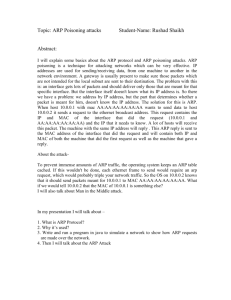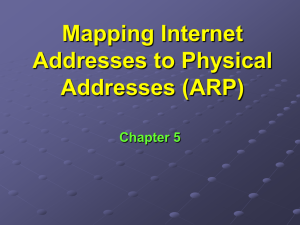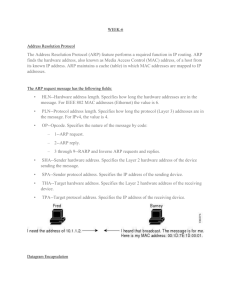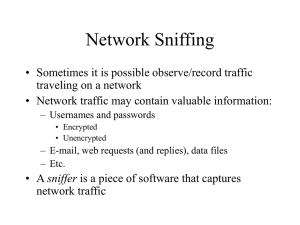Chapter5
advertisement
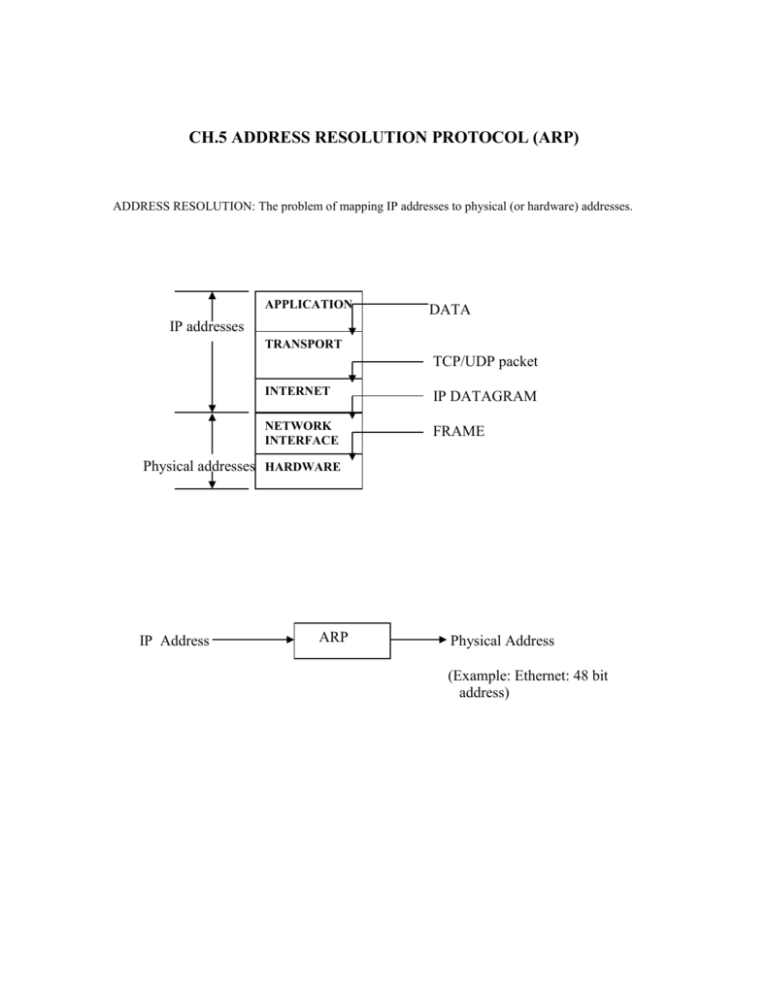
CH.5 ADDRESS RESOLUTION PROTOCOL (ARP) ADDRESS RESOLUTION: The problem of mapping IP addresses to physical (or hardware) addresses. APPLICATION DATA IP addresses TRANSPORT TCP/UDP packet INTERNET IP DATAGRAM NETWORK INTERFACE FRAME Physical addresses HARDWARE IP Address ARP Physical Address (Example: Ethernet: 48 bit address) FIG: Example: FTP Client connected to FTP server Sender/Receiver Receiver/Sender FTP Server FTP Client TCP TCP IP IP Token Ring DRIVER Ethernet DRIVER ETHERNET NETWORK TOKEN RING NETWORK Ethernet DRIVER TOKEN RING DRIVER IP ROUTER FIG: Example: A small part of Internet 131.108.22.177 131.108.154.88 A B1 N1: 131.108.0.0 131.108.0.1 R1 78.0.0.1 N2: 78.0.0.0 B2 78.0.0.3 78.0.0.2 R2 N3 R3 223.240.129.1 N4: 223.240.129.0 B3 ADDRESS RESOLUTION 1. Using Table Lookup (STATIC MAPPING) Example table: IP Address Hardware Address 191.21.31.1 0A:07:4B:12:82:36 191.21.31.2 0A:07:4B:12:82:8D 191.21.31.3 0A:07:4B:12:82:99 191.21.31.4 0A:07:4B:12:82:1F 191.21.31.5 0A:07:4B:12:82:28 A separate address binding table for each physical n/w. Search Method: (i ) Sequential search for a network less the a dozen hosts (ii) Hashing (iii) Direct indexing used in WAN technologies PROBLMES: 1) Changes in NIC 2) Mobile Computer 3) In some LAN's like local Talk, the PHY ADD changes, every time the computer is turned on. 2. Closed Form Computation IA = f (HA) Used for technologies with configurable address. Example: PRONET 3. Dynamic Mapping o ARP Given: Target’s IP address. The target and the host (which wants to use ARP to find the target's physical address) are on the same physical network. To Find: Target’s physical address. ARP MESSAGE FORMAT VARIABLE LENGTH FIELDS (28 Octets for Ethernet) 1 8 16 PROTOCOL TYPE HARDWARE TYPE HLEN 24 PLEN OPERATION SENDER HA (Octets 0 – 3 ) SENDER HA (Octets 4 – 5) SENDER IP (Octets 0 – 1) SENDER IP (Octets 2 – 3) TARGET HA (Octets 0 – 1) TARGET HA (Octets 2 – 5 ) TARGET IP (Octets 0 – 3 ) Hardware Type: 1 for ETHERNET Protocol Type: 080016 for IP HLEN, PLEN: Lengths of Hardware & Protocol Address in OCTETS Operation: Type of operation Value of the field ARP Request 1 ARP Response 2 RARP Request 3 RARP Response 4 31 Target HA: In ARP Request, it is filled with all Zeros. In ARP Response, it contains the HA Fig: Ethernet frame for ARP packet: Ethernet Type for ARP 080616 HA DEST 6 HA T Y P E SRC 6 2 H T Y P E 2 PT Y P E 2 H S I Z E P S I Z E 1 1 O P E R A TI O N 2 IP HA ADD SENDER IP HA TARG ET SENDER 6 4 6 P A PADDD TAR D GET I N ING G C ADD 4 18 R C 4 ARP Message ARP Process RECEIPT by a system of an ARP Request – addressed to the system - updates the cache with the IP and HA of the Sender - generates the ARP response ARP Request is broadcast. All the machines on the LAN update their ARP cache with the IP & HA of the Sender. Another use of ARP USE: A Back-up file server can take over from a failed server by sending an ARP Request with the failed server’s IP Add and the back-up server’s HA. ( Bhide, Elnozahy and Morg – 1991) To create an ARP request (I) Change OPERATION field value to 2 (II) Exchange the Sender and Target IP addresses (III) Put in the HA of the respondent-system (IV) Put in the HA of the Target, the HA of the machine, which sent the ARP Request ( This HA available in the ARP Request in the HA field of the Sender.) ARP PROCESS: Query (also called the Request) broadcast over the n/w. Response unicast to the inquirer. Example: Using Ethernet to carry ARP Request ARP REQUEST: D.A. 8 S. A. 6 6 TYPE 2 ARP REQ PACKET Preamble 4 CRC DEST- FF:FF:FF:FF:FF:FF TYPE 0806 ARP Response/Request 4 CASES: SENDER HOST (A) HOST (A) ROUTER(R1) ROUTER(R3) RECEIVER HOST(B1) ON THE SAME NET (N1) HOST(B2)ON A DIFFERENT NET(N2) HOST (B3) ON A DISTANT NET (N4) HOST (B3) connected to a N/W directly connected to the Router (N4) REMARKS IP of ROUTER (R1) to be used IP of the next ROUTER (R2) ARP Components - ARP Cache: To reduce communication cost – A cache of recent IP-to-Physical address bindings is maintained. Technique of Soft State – for storing information that can become STALE, without warning, Protocols use Timers. Preset time elapses->information deleted Advantages of Soft State 1. Autonomously determines validity; no need for a reference to an external host. 2. No dependence on n/w hardware. Disadvantage – The sender may go on sending packets, during the validity period, even if the Dest Host has crashed. Cache Manager: cache control module Cache table/ARP table Processing an Incoming ARP message Input Module – - Extract the sender’s address and if the cache contains the item, update it. Examine operation If ARP request – Compare target IP address with the local IP address. If identical – Reverse the sender & target binding. Insert the hardware address. Change Operation field to 2. Send the response. If not identical STOP. If ARP Response If ARP Response – The system may have been waiting for it. If the state is Pending - Update the entry. While the Q is not empty DeQ one packet, send the packet. If the state is Resolved - update the entry. ARP SYSTEM: OUTPUT MODULE CACHE TABLE CACHE CONTROL MODULE QUEUES (One for each destination) INPUT MODULE CACHE TABLE: The fields in the Cache Table are as follows: 1. STATE : RESOLVED , PENDING, FREE 2. Queue number 3 Number of Attempts* 4 Time Out. 5 IP Address 6 Hardware Address 7. Last use: set to 0 initially and made equal to time when the row is used 8.Revalidation Timer : made equal to 50 to 75% of Timeout. 9.Hardware Type Address 10.Protocol Type 11.HA length in bytes 12.PA length in bytes 13.Interface number (Multi-homed host Routers) *Either a maximum no. of attempts or a timeout for a pending entry is provided. Usual value of this timeout is 3 minutes. CACHE CONTROL MODULE It periodically ( say every 5 seconds), checks the cache table. It updates the fields of the table appropriately. Jitter and Revalidation Timer: Jitter: Change in packet transfer time: For some packets, transfer may be preceded by ARP request and response. If the hardware address is available in the Cache Table, the packet will be directly transferred. Timeout can become zero at any time, after which the ARP request and response may be required. To avoid jitter: Revalidation Timer: Revalidation Timer On expiry of Revalidation Timer, CCM checks whether the hardware address has been used recently. If so, when the RT times out, a new Request is sent out ( even when no new packet for outputting is there.) If Timeout becomes 0, while we are waiting for a response to the request, the row is not cleared unless the max no of attempts have been tried. Pseudo code for updating the cache table: CCM periodically ( say every 5 seconds), checks the cache table. It updates the fields of the table as follows: If the STATE is PENDING 1- Increment the No. of Attempts by one. 2 If No of Attempts > Max a- change the state to FREE b- Destroy the corresponding queue 3- if not send another ARP Request If the state is resolved On receipt of a new response (to RT time out request ?) both the timers are reset. Decrement the value of Timeout and RT by elapsed time. ( Do not decrease below 0.) If RT times out, put Attempts = 1 and send an ARP request. If RT = 0 AND if Timeout > 0, increments the No. of Attempts by one. If Timeout <=0 AND if Attempts >= Max, - change the State to FREE & destroy the corresponding queue. A router has multiple ARP modules, each with its own ARP table. QUEUES: One for each destination OUTPUT MODULE: (Input to the Module: from IP layer) STEPS: Check the cache. If Found - If State is resolved extract HA and Send. - If state is pending enqueue the packet. If not found1- Create a Q. 2- Enqueue the Packet. 3 Create a cache entry with STATE Pending, ATTEMPTS one 4. Send an ARP Request. Cache control – Sends ARP requests, if more than one Attempt is required Example: Immediately after a cache control update, the cache is as follows: State Q Att T-O IP-add HA R 2 - 800 141.34.0.1 38:AC:45:63:AE:38 P 5 1 - 141.34.8.251 - F - - - P 8 9 - 141.34.56.3 - R 12 - 50 141.34.56.88 38:AC:45:45:95:85 - - State: Resolved/Pending/Free; Q: queue number; Att: No. of Attempts; T-O: TimeOut; IP-add: IP address; HA: Hardware Address Given that Max Time-out 20 minutes, Max number of attempts 10 The Cache Control Module updates the Cache Table every 10 seconds. STEP:(1) 8 seconds after CCU: Output Module receives an IP packet with destination address of 22.38.56.88 STEP:(2) 25 seconds later :Input Module receives an ARP response for 141.34.8.251 with an address of E3:B5:38:A9:49:C3 STEP:( 3) 15 second later : Output module receives an IP packet with destination address of 12.0.28.38 STEP:(4). 26 seconds later : Input Module receives a ARP Request from IP addr;141.34.8.38 HA : 25:35:45:55:65:75 But the target IP address is not of this machine Draw the cache table after the request is received and processed.

